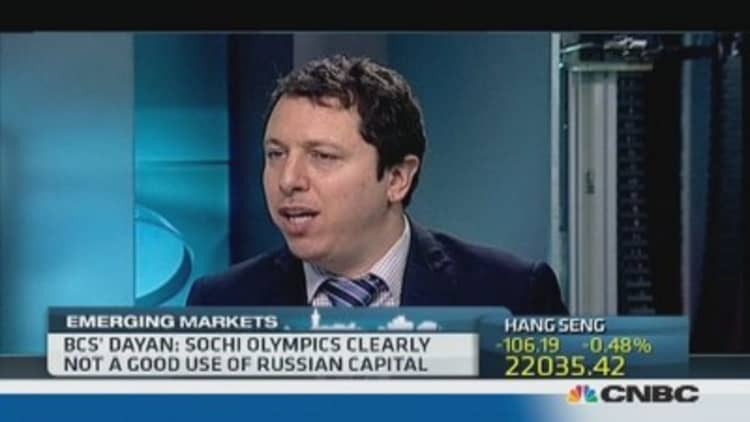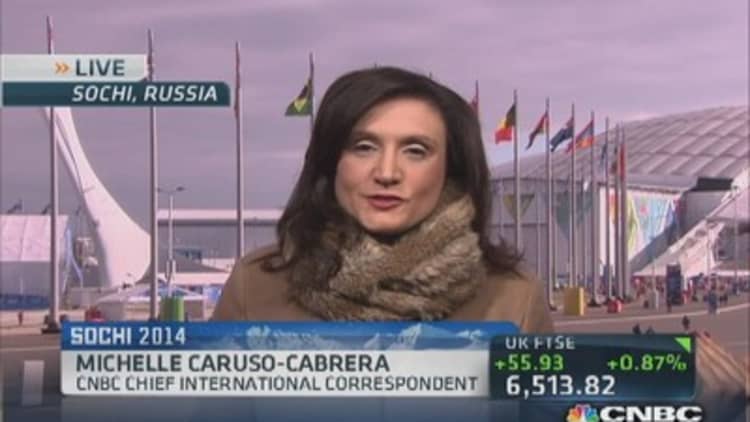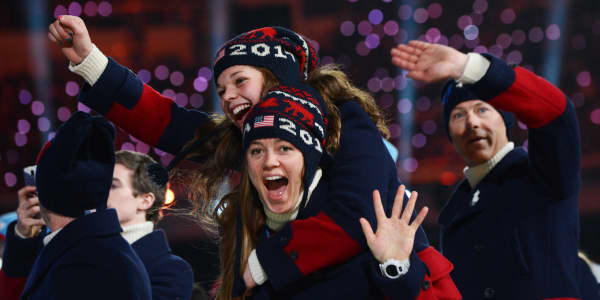Getting to the Olympics takes a lot of talent. It also takes a lot of money. And for most Olympians, that means finding sponsors.
Olympians' paths to corporate sponsorship are riddled with challenges, but U.S. alpine ski racer Ted Ligety says the bottom line is simple: "If you're not winning, you're not going to get sponsored."
The alpine star: Talk to my agent
For Ligety, a gold medalist in the 2006 Turin Olympics and winner of multiple world championships, that hasn't been a problem.
Going into Sochi, he enjoys sponsorships from Fortune 500 companies such as Coca-Cola, Procter & Gamble, Kellogg, and Citigroup, as well as from prominent makers of athletic equipment, including Head.
(Read more: Reporters vent on Twitter about Sochi hotels)
"I get paid," said Ligety of his sponsorship income. "I make seven figures every year."
But it wasn't always that way.
For years, his parents were his only "sponsors," Ligety said. To illustrate that point during competitions, he displayed the words "Mom and Dad" across the front of his helmet—real estate that's usually reserved for a skier's top supporter.
After he bit into Olympic gold, Ligety no longer needed such attention-grabbing ploys, and he now retains an agent to take care of sponsorship details.
Biathlete: An American in a European sport
But for Tim Burke, a top-ranked American athlete in the ski-and-shoot sport of biathlon, an agent is a luxury that's not in the budget.
Part of the reason is biathlon's relatively low profile in the U.S., he said, compounded by the fact that no American has ever medaled in an Olympic biathlon event.
"It's a hugely popular sport in Germany and Norway," Burke said. "But I'm an American in a predominantly European sport."
According to Max Cobb, CEO of the U.S. Biathlon Organization, a top U.S. biathlete like Burke may be able to earn between $50,000 and $60,000 a year through a combination of government stipends, sponsorships and prize money from World Cup events.
(Read more: Welcome to Sochi. You're hacked!)
That livable but less-than-princely income has meant that throughout his career, Burke—who had a disappointing showing in the 2010 Vancouver Olympics—has approached potential patrons via hundreds of personal cold calls and emails.
Though he receives about an 80 percent response rate, he said, relatively few sponsorships have materialized.
"Through a cold call or a cold email, that's really tough," Burke said. "I've probably been turned down 100 times."

But he has also netted some successes, and Burke now counts TD Ameritrade, among other companies, as sponsors.
But his longest-standing sponsorship is the indirect result of a hip injury. After having hip surgery more than 10 years ago, Burke recalled, he called the maker of Synflex, a joint health supplement he was taking to aid his recovery.
"I sought them out because I was using their product and really liked it," he said, adding that the company liked his story as well. It has been a sponsor since 2002.
Despite the payoff, Burke has to balance self-marketing with training. In the run-up to Sochi, Burke said, he stopped hunting for sponsors this past summer.
"It definitely takes some time and energy, so I try and focus on that more in the off-season," he said of his sponsorship drives. "Around August, I said, OK, that's enough."
Figure skater: I'll take the boots
U.S. figure skating prospect Max Aaron, 21, is also no stranger to the balance between earning and training.
Within the past two years, he worked a six-week stint at a restaurant to pay his bills, while also training and attending college.
"I was a host, and a busboy, and a barback," Aaron said. "That was really hard."
That was just months before he won the 2013 U.S. national figure skating championships to become a leading contender for a place on the U.S. Olympic team.
Aaron now has two notable sponsorships, from the insurer Liberty Mutual and from Edea, an Italian maker of skate boots.
Though he would not discuss the specific financial consideration they provide, a spokesman for Liberty Mutual said that its total payment to him was under six figures.

Aaron said his deal with Edea began about four years ago and was initially entirely equipment-based.
"They sponsored me with a pair of boots first," he said. "Getting a pair of boots or two a year is huge because it certainly helps me pay that bill, and pay the rent instead. The boots go for $800, and the blade can be another $300 or $400."
Like the biathlete, Burke, Aaron does not have an agent. He enlists the help of a friend who is a lawyer to review contracts.
"I'm pretty much new on the scene, so my goal was to win medals and then have companies come to me," he said. "Hopefully I'll have an agent soon, so that I don't have to focus on contracts."
Aaron thinks he may even become a sports agent in the future.
"One of the first things I wanted to get into was being a sports agent," he said of his early career aspirations. "But now I guess I have a chance to learn as an athlete."
—By CNBC's Adam Molon. Follow him on Twitter: @CNBCMolon




